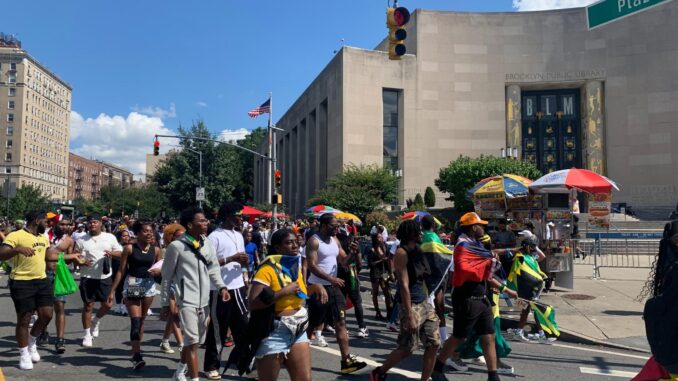
Monday, September 2, 2024 marked the annual celebration of the J’Ouvert and West Indian American Day Carnival. A Brooklyn tradition rooted in hundreds of years of history and culture, the annual Carnival is a celebration of the many diverse cultures across the West Indian and Caribbean islands. The event has long been organized by the West Indian American Day Carnival Association.
Celebrations began at daybreak with the traditional playing of steel drums. Several hours into the parade, around 2:35pm, a gunman opened fire into the crowd along the Eastern Parkway parade route, leaving one dead and four others injured, as reported by the AP.
In a statement, NYPD Chief of Patrol John Chell said this was not believed to be a random attack. The Carnival festivities continued on into the evening, parade-goers undeterred by the shooting.
The streets of Brooklyn were lined with hundreds of flags representing countries of the West Indian and Caribbean islands such as Trinidad and Tobago, Barbados, Jamaica, and Haiti, just to name a few. Many Carnival participants donned fantastical feathered masks and brightly colored costumes. These costumes take influence from history, politics, culture, and elements from both the spiritual and natural world.
The calypso music and thousands dancing in the street reflected a celebratory energy.
Mary Cadette, a 58-year-old woman flag vendor originally from St. Lucia said, “This is one of my favorite times of the year, I see a lot of old friends.”
The parade is not only enjoyed by those of West Indian and Caribbean descent. As one of the world’s largest annual celebrations of Caribbean culture, the event draws in millions of spectators from all backgrounds.
Leanne Ryan, a 34-year-old woman originally from Connecticut and now living in Park Slope, attended the event with her two children.
“It’s important to me that my kids grow up around different cultures,” Ryan said. “Besides, what kid doesn’t like a parade?”
According to the West Indian American Day Carnival Association, the annual celebrations originated in Harlem in the 1930s. It was organized by a Trinidadian woman named Jessie Wardell and her friends. Eventually the celebration moved to Brooklyn in the 1960s, led by a Trinidadian man named Rufus Goring.
The origins of J’Ouvert, or, ‘daybreak’, actually dates back hundreds of years originating in Trinidad. Through colonialism and the slave trade, these traditions spread throughout the West Indian and Caribbean Islands. When the Caribbean and West Indian people were enslaved however, they were forbidden from carrying out their own cultural traditions or holding or participating in any kind of outdoor celebrations. This gives the bright and loud Carnival of today an even deeper meaning. Beyond a proud celebration of individual heritage, it is a celebration of freedom, expression, and history to be enjoyed by all.
